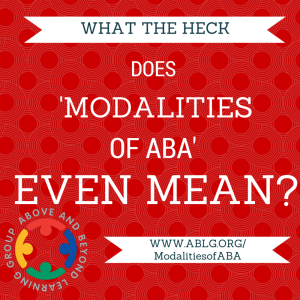
What does an ABA Agency, Clinic, or Provider mean when it says, “We use multiple modalities of ABA?”
When you’re new to Applied Behavior Analysis, it sounds great to have all the “bells and whistles”. You might not know what “multiple modalities” are, but it sure does sound important to have them.
Let’s talk about some of the things that service providers might mean when they say “Mutiple Modalities of ABA”.
This is just an overview to orient you to some of the different “modalities” of ABA. Be sure to ask the service provider exactly what they mean when they offer “Multiple modalities of ABA”.
“Modalities” might mean one of two things (or both!)
1) Teaching Procedures
There are several types of teaching procedures that are based in the principles of Applied Behavior Analysis that can be used to target skills. These include chaining, shaping, Natural Environment Teaching, incidental teaching, and discrete trial training, to name a few. It might also refer to “errorless learning” or different styles of teaching using ABA.
2) “Types” of ABA
There are subsets of Applied Behavior Analysis such as Applied Verbal Behavior and Positive Behavior Supports that might be applicable to certain skills or even an entire program. These might also be called “modalities” of ABA.
In today’s post, we’re looking at the first category: Teaching Procedures.
Discrete Trial Training (DTT): DTT is typically used for skills that involve discrete units of teaching, such as colors, numbers, labeling, answering “WH” questions, or responding to and initiating bids for joint attention. DTT is the most commonly known teaching procedure within Applied Behavior Analysis, although there are a lot of misconceptions about DTT. A discrete trial simply means that a single item or single target is broken down into a discrete learning unit consisting of: A specific direction (or “discriminative stimulus/Sd”), response, and consequence. Prompts may be used to help the learner engage in the correct response. DTT is most commonly done at a “work table,” but can actually be done anywhere.
Chaining: “Chaining” teaching procedures are typically used for a skill that involves many steps “chained” together, such as tying shoes, hygiene skills, or following recipes. Chaining procedures involve breaking down those skills into smaller, manageable components (called a Task Analysis). The steps are then “chained” together systematically to promote success and independence.
Natural Environment Teaching (NET): NET is a teaching modality that, contrary to popular belief, does NOT mean just taking work materials off the table and moving them to a play area or floor. NET is a systematic introduction of learned skills into the natural environment to promote generalized behavior change. In a NET teaching paradigm, the instructor also begins incorporating more natural reinforcement. For example, instead of teaching Color Identification using flashcards at a work table, the instructor might intentionally set up a racing car set with the targeted color cars. The instructor will still present a clear instruction, prompt if needed, and reinforce or correct the response. NET should be accompanied by a teaching plan or formal plan, in contrast to Incidental Teaching.
Incidental Teaching: Incidental teaching refers to capturing naturally occurring opportunities to teach targeted skills. While Natural Environment Teaching requires contriving the environment, incidental teaching means capturing opportunities as they arise.
Next week, we’ll shine a light on some other “modalities” of ABA that fall under the “Types of ABA” category.
In the meantime, hop over to our Facebook page and tell us: What other “ABA” jargon would you love some clarity on?

Leave a Reply